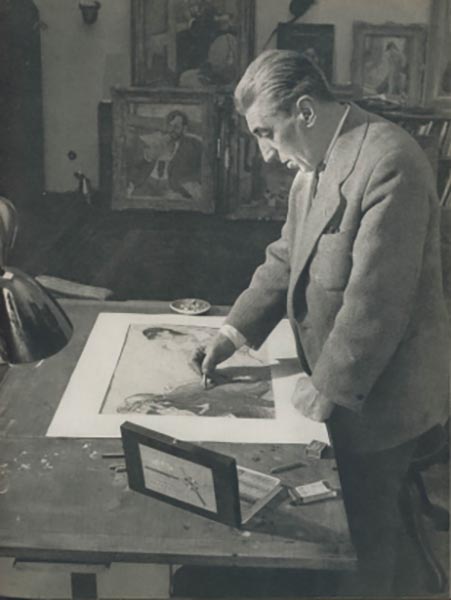Antonín Pelc (January 16, 1895 - March 24, 1967) was a Czechoslovak caricaturist, illustrator, and painter. Born in Lišany, Pelc studied painting at the Prague Academy in the studio of Max Pirner and Vlaho Bukovac. Pelc became a well-known antifascist artist and participated in the 1934 International Exhibition of Caricature and Humour in Prague. The German ambassador protested against and asked for the removal of the most violent anti-Nazi pieces, many of which were created by Pelc. In April 1939, after Germany invaded Czechoslovakia, Pelc, Adolf Hoffmeister (1902 - 1973), and other Czechoslovak antifascists fled to Paris. In Paris, Hoffmeister founded the Maison de la Culture Tchécoslovaque (House of Czechoslovak Culture in Paris. The Maison became a cultural center and a refuge for Czechoslovak painters, writers, professors, musicians, and journalists in exile. However, in September 1939 after France declared war on Germany following the German invasion of Poland, the police raided the house believing it to be the headquarters of the Czechoslovak Communist Party in exile. Pelc, Hoffmeister, and all the other residents of the house were arrested and imprisoned on charges of being enemy spies. After serving six months in La Santé Prison, Pelc, Hoffmeister, and two other artists made their way to Casablanca, Morocco, where Pelc was interned as an unwanted alien. Eventually Pelc and the other artists secured passage to Martinique, and from their Pelc made his way to New York City. In 1946 Pelc recalled of his arrival in New York, 'When we reached the United States, we saw America as a paradise after all that time running from jail to jail and from camp to camp. I was so happy finally to be left alone that I started to paint and draw immediately'. After a year, Pelc restarted working on propaganda and political caricature, publishing work in the Czechoslovak newspaper in New York and other publications. He created propaganda posters for the Czechoslovak Relief Committee and the United Czechoslovak Relief, among several other organizations. In 1943 Pelc (as Peel) and Hoffmeister exhibited their work at the Museum of Modern Art in an exhibition entitled War Caricatures by Hoffmeister and Peel. After the war, Pelc returned to Prague and joined the Communist Party. He was appointed a professor of illustration at the School of Applied Arts in Prague in 1946 and became a professor at the Academy of Fine Arts in Prague in 1955. In his later years Pelc devoted himself to painting, with much of his later work influenced by cubism.



